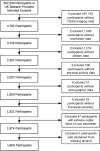Beer, wine, and spirits differentially influence body composition in older white adults-a United Kingdom Biobank study
- PMID: 36238230
- PMCID: PMC9535674
- DOI: 10.1002/osp4.598
Beer, wine, and spirits differentially influence body composition in older white adults-a United Kingdom Biobank study
Abstract
Background: Aging is characterized by body composition alterations, including increased visceral adiposity accumulation and bone loss. Alcohol consumption may partially drive these alterations, but findings are mixed. This study primarily aimed to investigate whether different alcohol types (beer/cider, red wine, white wine/Champagne, spirits) differentially associated with body composition.
Methods: The longitudinal UK Biobank study leveraged 1869 White participants (40-80 years; 59% male). Participants self-reported demographic, alcohol/dietary consumption, and lifestyle factors using a touchscreen questionnaire. Anthropometrics and serum for proteomics were collected. Body composition was obtained via dual-energy X-ray absorptiometry. Structural equation modeling was used to probe direct/indirect associations between alcohol types, cardiometabolic biomarkers, and body composition.
Results: Greater beer/spirit consumptions were associated with greater visceral adiposity (β = 0.069, p < 0.001 and β = 0.014, p < 0.001, respectively), which was driven by dyslipidemia and insulin resistance. In contrast, drinking more red wine was associated with less visceral adipose mass (β = -0.023, p < 0.001), which was driven by reduced inflammation and elevated high-density lipoproteins. White wine consumption predicted greater bone density (β = 0.051, p < 0.005).
Discussion: Beer/spirits may partially contribute to the "empty calorie" hypothesis related to adipogenesis, while red wine may help protect against adipogenesis due to anti-inflammatory/eulipidemic effects. Furthermore, white wine may benefit bone health in older White adults.1.
Keywords: adiposity; alcohol; body composition; wine.
© 2022 The Authors. Obesity Science & Practice published by World Obesity and The Obesity Society and John Wiley & Sons Ltd.
Conflict of interest statement
The authors have no conflicts of interest to report.
Figures


Similar articles
-
Alcohol consumption and its correlation with medical conditions: a UK Biobank study.Front Public Health. 2024 May 22;12:1294492. doi: 10.3389/fpubh.2024.1294492. eCollection 2024. Front Public Health. 2024. PMID: 38841662 Free PMC article.
-
Drink types unmask the health risks associated with alcohol intake - Prospective evidence from the general population.Clin Nutr. 2020 Oct;39(10):3168-3174. doi: 10.1016/j.clnu.2020.02.009. Epub 2020 Feb 15. Clin Nutr. 2020. PMID: 32111522
-
[Hypothetical Alcohol Consumption Interventions and Hepatic Steatosis: A Longitudinal Study in a Large Cohort].Sichuan Da Xue Xue Bao Yi Xue Ban. 2024 May 20;55(3):653-661. doi: 10.12182/20240560503. Sichuan Da Xue Xue Bao Yi Xue Ban. 2024. PMID: 38948274 Free PMC article. Chinese.
-
Alcohol Consumption and Cardiovascular Health.Am J Med. 2022 Oct;135(10):1213-1230.e3. doi: 10.1016/j.amjmed.2022.04.021. Epub 2022 May 14. Am J Med. 2022. PMID: 35580715 Free PMC article.
-
Behavioral and social consequences related to the consumption of different beverage types.J Stud Alcohol. 1996 Jan;57(1):77-84. doi: 10.15288/jsa.1996.57.77. J Stud Alcohol. 1996. PMID: 8747505 Review.
Cited by
-
Non-Alcoholic Beer Influences Glucose and Lipid Metabolism and Changes Body Composition in Healthy, Young, Male Adults.Nutrients. 2025 May 9;17(10):1625. doi: 10.3390/nu17101625. Nutrients. 2025. PMID: 40431365 Free PMC article. Clinical Trial.
-
Alcohol consumption and its correlation with medical conditions: a UK Biobank study.Front Public Health. 2024 May 22;12:1294492. doi: 10.3389/fpubh.2024.1294492. eCollection 2024. Front Public Health. 2024. PMID: 38841662 Free PMC article.
-
Influence of Wine on Bone Mineral Density.Nutrients. 2025 Jun 11;17(12):1981. doi: 10.3390/nu17121981. Nutrients. 2025. PMID: 40573092 Free PMC article. Review.
-
Wine, Polyphenols, and the Matrix Effect: Is Alcohol Always the Same?Int J Mol Sci. 2024 Sep 10;25(18):9796. doi: 10.3390/ijms25189796. Int J Mol Sci. 2024. PMID: 39337284 Free PMC article. Review.
-
The association between the healthy lifestyle index and MRI-derived body composition measurements in the UK Biobank study.Sci Rep. 2025 Jan 6;15(1):1010. doi: 10.1038/s41598-024-84406-z. Sci Rep. 2025. PMID: 39762360 Free PMC article.
References
-
- Larsen B, Klinedinst B, Le S, et al. Pick your poison carefully: how alcohol consumption and serum biomarkers influence body fat – a UK Biobank study. Innovation Aging. 2020;4(Supplement_1):889.
-
- Tolstrup JS, Heitmann BL, Tjønneland AM, Overvad OK, Sørensen TI, Grønbaek MN. The relation between drinking pattern and body mass index and waist and hip circumference. Int J Obes. 2005;29(5):490‐497. - PubMed
-
- Kleiner KD, Gold MS, Frost‐Pineda K, Lenz‐Brunsman B, Perri MG, Jacobs WS. Body mass index and alcohol use. J Addict Dis. 2004;23(3):105‐118. - PubMed
-
- Männistö S, Uusitalo K, Roos E, Fogelholm M, Pietinen P. Alcohol beverage drinking, diet and body mass index in a cross‐sectional survey. Eur J Clin Nutr. 1997;51(5):326‐332. - PubMed
Grants and funding
LinkOut - more resources
Full Text Sources
